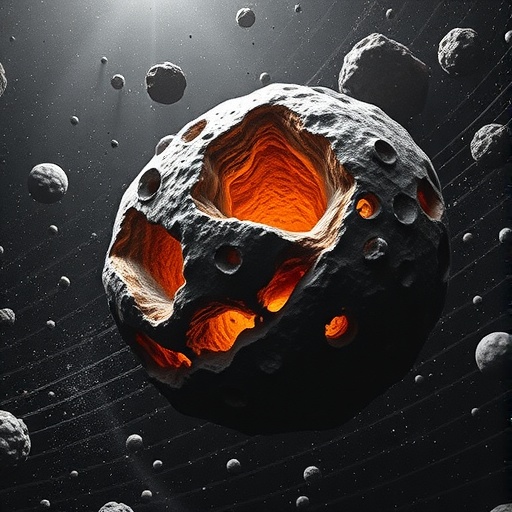Understanding the intricate dynamics of asteroids has taken a significant leap forward with recent revelations concerning their rotational behavior. Asteroids, those celestial wanderers that occasionally threaten our planet, demonstrate a wide variety of spinning patterns — some rotate seamlessly on their axes while others tumble chaotically through space. These behaviors, as recent studies show, are profoundly influenced by their collision history. The findings, which were presented at the EPSC-DPS2025 Joint Meeting held in Helsinki, leverage a wealth of data collected from the European Space Agency’s Gaia mission. This immense dataset provides invaluable insights and enhances our ability to calculate the physical characteristics of asteroids, a crucial step for planetary defense initiatives aimed at diverting potential collisions with Earth.
The Gaia mission represents a monumental effort in astrometric precision, surveying the entire sky to gather unprecedented levels of detail about celestial objects, including asteroids. By analyzing the light curves of these asteroids— the variations in light intensity as they rotate— researchers have begun to unravel the mystery of asteroidal rotations. These light curves enable scientists to chart a graph that plots rotation periods against asteroid diameters, revealing an intriguing divide within the data. This divide has long puzzled astronomers, signaling two distinct classifications of rotational behavior among asteroids.
Dr. Wen-Han Zhou, a prominent figure from the University of Tokyo, spearheaded a study that delves into this divide and seeks to answer enduring questions surrounding asteroid behavior. He articulated the momentous impact of the Gaia dataset on their breakthroughs. Alongside advanced modeling and artificial intelligence algorithms, Zhou’s team has started to uncover the complex physics governing these celestial bodies. The findings suggest that understanding an asteroid’s collision history is a determining factor for its rotational state.
In constructing a new model of asteroid spin evolution, Zhou and his team explored the interplay between two pivotal factors: the impacts from collisions within the Asteroid Belt and the effects of internal friction. These elements engage in a constant tug of war, with collisions jostling asteroids into a chaotic state and internal friction gradually stabilizing their spin. This balance— a critical point observed in the study— establishes a natural division line within the asteroid population, providing clarity to a long-standing enigma in astronomical circles.
Through the nuanced application of machine learning techniques on the Gaia asteroid catalogue, Zhou’s team demonstrated that their theoretical model’s predictions nearly precisely aligned with empirical observations. They discovered that the gap in rotational behavior is not merely an anomaly but a fundamental trait of asteroids whereby those beneath this line exhibit slow tumbling with periods under 30 hours, while those above it maintain faster, more stable rotational dynamics.
The research sheds light on why a significant number of asteroids exhibit wild tumbling motions instead of harmonious spins around a singular axis. Findings indicate that such tumbling typically initiates during slow rotations, rendering asteroids susceptible to disruptions from collisions. These events can catapult an asteroid into a tumbling motion, which is more common among smaller bodies.
Interestingly, one might presume that sunlight would fortify the rotational stability of asteroids by exerting forces that influence how they spin. However, the opposite is true for tumbling asteroids. The phenomenon stems from how sunlight interacts with an asteroid’s surface. For asteroids that spin uniformly, the absorption and re-emission of heat energy occur consistently in one direction. Consequently, the force from sunlight gradually accelerates their rotation.
Conversely, tumbling asteroids, with their erratic rotation, experience fluctuating interactions with sunlight. As disparate parts of the surface absorb and emit heat at varying rates, the resultant effect cancels itself out. This situation leads to a sluggish change in spin among these tumbling bodies, trapping them in a slow-rotation zone below the distinctive gap observed in Gaia’s dataset.
Finding practical implications from this research, the insights gleaned enhance the understanding of an asteroid’s internal structure and how this relates to its rotational dynamics. The information acquired from the Gaia mission fits into an evolving picture depicting asteroids as loosely constructed, rubble-like aggregations rather than solid entities. The knowledge is pivotal for planetary defense strategies, especially regarding the potential deflection of hazardous asteroids on a collision trajectory with Earth.
The research anticipates improvements in how we catalog and assess the internal properties of these celestial bodies. Grasping the internal structures of asteroids could significantly influence the methodology behind deflecting them. Rubble pile asteroids, in particular, would react differently to kinetic impacts compared to a denser, rigid body. Thus, with continuous advancements, astronomers may soon create an expansive catalogue detailing the internal configurations of numerous potentially hazardous asteroids.
In light of these findings, the prospect of future astronomical surveys, such as the Vera C. Rubin Observatory’s Legacy Survey of Space and Time (LSST), raises compelling possibilities. Zhou emphasizes that the lessons learned from this study can be applied to millions more asteroids moving forward, refining our comprehension of their evolution, structure, and, ultimately, their associated risks.
This remarkable integration of technology and astrophysics underscores a pivotal moment in understanding the mechanics of asteroids. With continuous exploration and analysis, the cosmos may hold even more secrets waiting to be unraveled, paving the way for advancing our defense strategies against potential threats emanating from space.
Subject of Research: Asteroid Rotation and Dynamics
Article Title: Insights into Asteroid Rotations: A Breakthrough from the Gaia Mission
News Publication Date: [Insert Publication Date]
Web References: [Insert Web References]
References: [Insert References]
Image Credits: Europlanet/T Roger
Keywords
Asteroids, Gaia Mission, Astronomical Research, Astrophysics, Planetary Defense, Collision History, Rotational Dynamics, Machine Learning, Light Curves.




